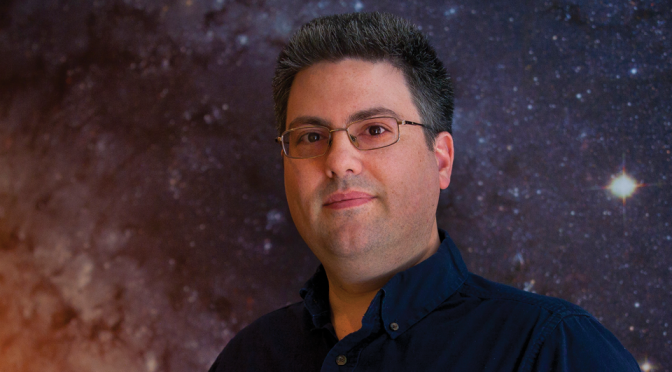Meet astronomer Mark Brodwin, assistant professor of physics and astronomy. When he’s not researching and discovering unique galaxy clusters, he’s working as a NASA-nominated member of the Euclid Consortium mission, which is intended to launch in 2020.
What is your research interest?
My research involves the discovery and study of rare, distant galaxy clusters, which are gravitationally bound collections of hundreds or thousands of galaxies like our own Milky Way. While I primarily discover these clusters using infrared space telescopes, follow-up studies are done across the whole electromagnetic spectrum (including optical, X-ray and radio). These unique astrophysical objects are powerful probes of the underlying physics that drives the growth of the most massive galaxies and the evolution of the universe itself.
My last three first-author papers indicate the range of my work. In 2013, I published a paper measuring the rate at which new stars were being born in galaxy clusters at distances of between 7 and 9 billion light years. Last year, I wrote a paper describing radio measurements of the masses of five super-massive infrared-selected clusters in the early eniverse. Right now, I’m completing a paper on the thermodynamic properties of the hot X-ray gas in the most distant, massive cluster found to date. Discovered in an infrared survey of mine in 2012, it’s 10 billion light years away, weighs about 500 trillion suns and has a temperature of about 100 million degrees.
How does your research differ from Professor Dan McIntosh’s?
Professor McIntosh focuses on the processes that turn regular spiral disk galaxies, like the Milky Way, into sphere-like elliptical galaxies. His work spans a large range of environments, from nearly isolated galaxies to ones that live in close proximity to many other galaxies inside rich clusters. Our specific research interests overlap in these cluster regions, where I focus not only on the evolution of the galaxies, but also of the clusters themselves, and the implications for cosmology.
That said, we are both very interested in the full range of each other’s work. Indeed, we have merged our groups into the UMKC Galaxy Evolution Group, and we hold joint group meetings weekly.
What sparked your passion for astronomy?
As a child, I was always amazed by the night sky. However, growing up in a big city, I had no idea what it really looked like. I devoured books on the planets and was a huge Star Trek fan. When I got my first look at Jupiter and Saturn in a telescope comparable to the Warkoczevski Public Observatory here at UMKC, I was hooked.
Have you always known that you wanted to devote your life to studying astronomy?
Certainly since the last year of my undergrad. Before that, I was deciding between astronomy and fundamental topics in physics, such as particle physics or observational measurements of gravity waves. I definitely made the right decision.
Your research and interests are very specific, what draws you to study the specific areas that you do?
I like the multi-wavelength and even multi-disciplinary nature of the study of galaxy clusters. When I was a graduate student, astronomy was much more compartmentalized. People self-identified as optical, radio or X-ray astronomers, they specialized in spectroscopic or morphological techniques, and they worked on problems in either galaxy evolution or cosmology (for example). I do all those things and more, which is very stimulating. Every paper I write or new project I start involves a huge learning curve, which is a challenge I enjoy.
What are you currently working on?
I’m finishing up a paper on the X-ray properties of a very distant, massive galaxy cluster. I’m also working on a Hubble Space Telescope program, led by Nobel laureate Dr. Saul Perlmutter, which is searching for supernova explosions in some of my distant clusters.
In related research, I’m preparing for a Euclid Consortium meeting this summer in Lausanne, Switzerland. Euclid is a new space telescope being built for launch in 2020, which will probe dark energy in several independent and complementary ways.
What is one thing you wish everyone knew about the study of astronomy?
The thing I’d want people to know is that, as the study of the whole universe and everything in it, it is at once the most fundamental science and, in my opinion, the most inspiring on a personal level.
The fundamental nature is clear: astronomy’s contributions to fundamental physics include the Big Bang, cosmic inflation, the expansion of the universe, nucleosynthesis both in the early universe and today in stars, the cosmic microwave background, the formation of large scale structure (i.e. galaxies) and the existence of neutrino mass, dark matter and dark energy.
On a personal level, the study of astronomy is every bit as rewarding. Everybody who has ever really looked at the night sky from a dark site is overwhelmed by the sheer immensity of it all, and by how small we seem in comparison. In studying astronomy, one is able to get a real sense of perspective at a meaningful, quantitative level, of the incredible range of sizes, masses, ages, temperatures and energies of the universe and its constituent galaxies, stars and planets. Truly understanding our place in comparison is mind-blowing and deeply moving.
When you are not conducting research, what do you do in your free time?
These days I spend my time playing with my 2-year-old daughter, who is an absolute joy. I also enjoy playing guitar, cooking and, of course, trying to keep up with hockey — I’m Canadian.



